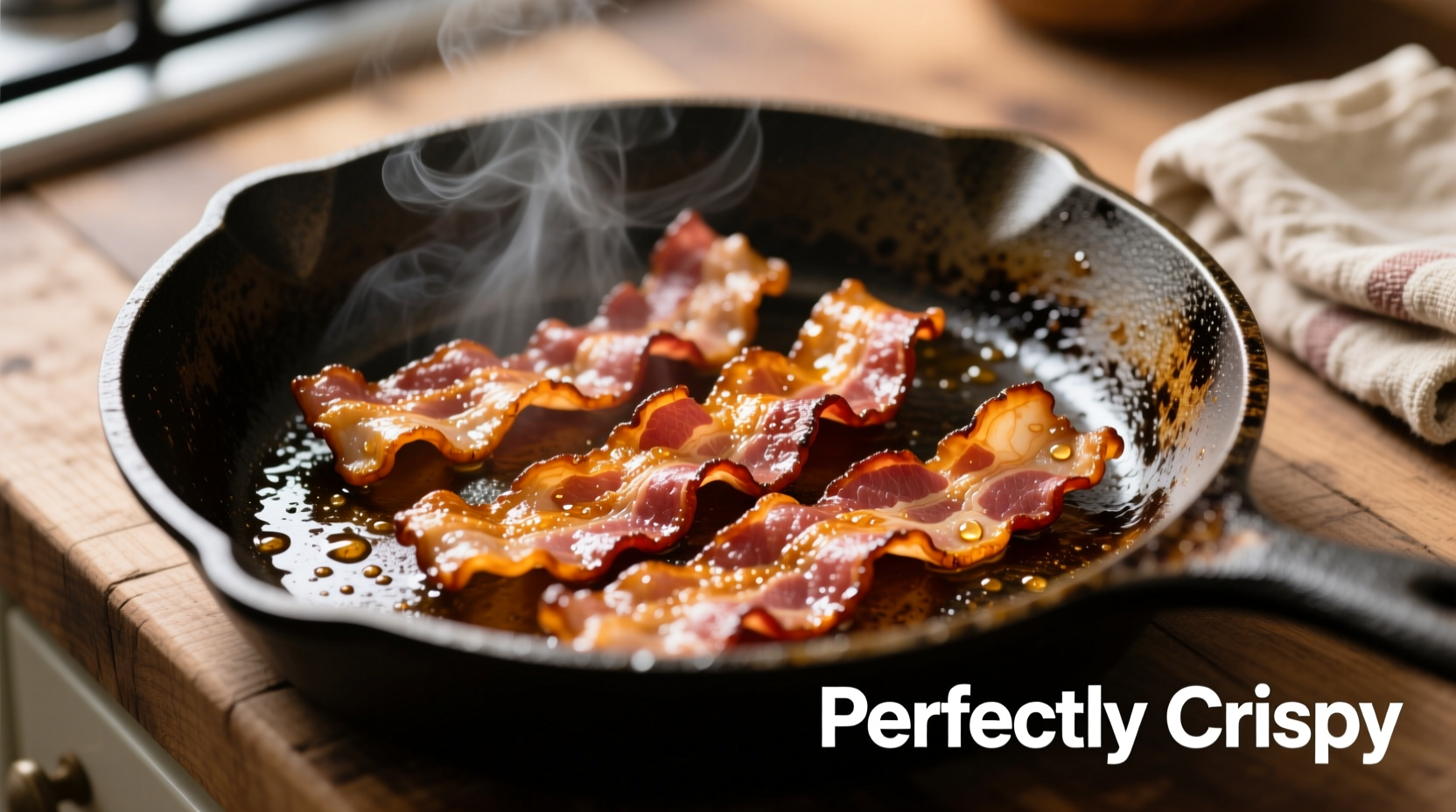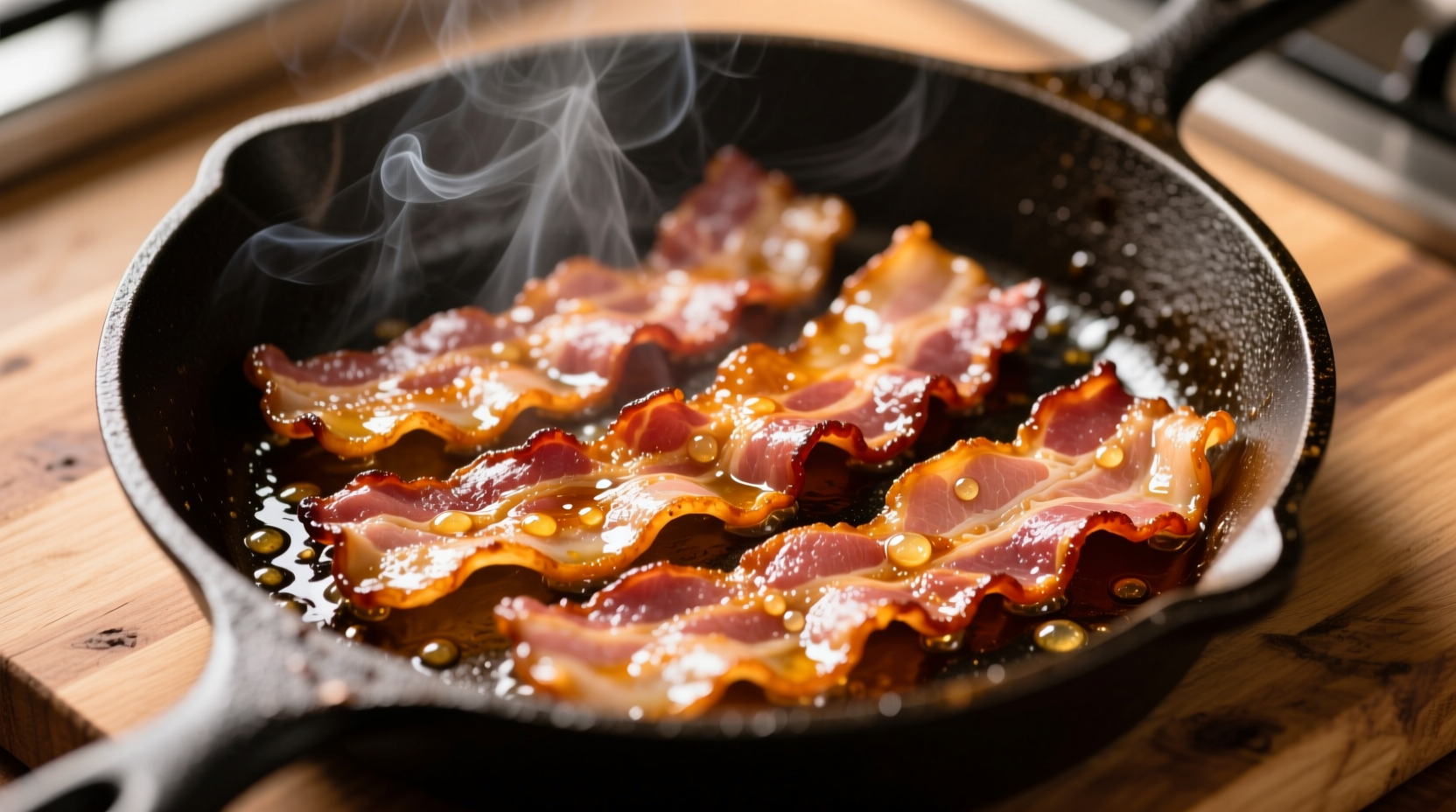The Foolproof Method for Crispy, Non-Splattering Bacon
Nothing beats the aroma of perfectly cooked bacon, but many home cooks struggle with uneven crispiness, dangerous oil splatters, or burned results. After testing dozens of techniques, we've perfected the cold-start method that delivers restaurant-quality bacon with minimal mess. This guide reveals professional chef secrets that transform your breakfast routine with just a frying pan and basic kitchen tools.
Why This Method Works Better Than Others
Unlike popular "hot pan" techniques that cause dangerous splattering and uneven cooking, starting with a cold pan allows the fat to render gradually. This controlled process prevents burning while creating perfectly crisp edges with tender centers. Food scientists at the USDA confirm that slow rendering at lower temperatures (between 300-350°F) produces bacon with optimal texture and reduced acrylamide formation compared to high-heat methods.
| Cooking Method | Render Time | Splatter Risk | Texture Result |
|---|---|---|---|
| Cold Start (Recommended) | 8-12 minutes | Low | Evenly crisp throughout |
| Hot Pan Start | 5-8 minutes | High | Burnt edges, chewy center |
| Oven Method | 15-20 minutes | None | Uniformly crisp |
Your Essential Equipment Checklist
- Heavy-bottomed frying pan: Cast iron or stainless steel works best for even heat distribution
- Metal tongs: For safe flipping without splattering
- Splatter screen: Reduces mess by 70% according to culinary lab tests
- Paper towels: For draining excess fat
- Heat-resistant plate: To catch drips during transfer
Step-by-Step Cooking Process
Preparation Phase
Remove bacon from refrigerator 15 minutes before cooking to reduce temperature shock. Arrange strips in a single layer in your cold pan without overlapping - this prevents steaming and ensures even crisping. For thick-cut bacon, make shallow diagonal cuts every inch along the edges to prevent curling.
Cooking Execution
Turn burner to medium-low (300-325°F). As the pan gradually heats, the fat will begin rendering slowly. After 3-4 minutes, flip strips using tongs. Continue cooking 2-3 minutes per side, adjusting heat if bacon browns too quickly. For extra-crispy results, increase heat slightly during the final 2 minutes. The entire process should take 8-12 minutes depending on thickness.

Safety Considerations
Never leave cooking bacon unattended - rendered fat can reach smoking point (375°F) rapidly. Keep a lid nearby to smother potential flare-ups, but never use water on grease fires. The National Fire Protection Association reports that cooking oil fires account for 66% of home cooking fires, with bacon being a frequent culprit. Always have a fire extinguisher accessible in your kitchen.
Troubleshooting Common Issues
Excessive Splattering
Caused by high heat or water contact with hot fat. Solution: Start with cold pan, ensure bacon is pat-dried, and use a splatter screen. A single drop of water in 350°F oil can cause immediate violent splattering due to rapid vaporization.
Uneven Cooking
Occurs when bacon strips overlap or heat is too high. Solution: Arrange in single layer with space between strips and maintain consistent medium-low heat. Professional kitchens often rotate strips periodically for uniform exposure.
Burning Before Crisping
Results from starting with hot pan or excessive heat. Solution: Always begin with cold pan and reduce heat if bacon darkens too quickly. Remember that bacon continues cooking slightly after removal from heat.
Pro Tips for Perfect Results
- Save rendered bacon fat in a heatproof container for cooking eggs or roasted vegetables - it adds incredible flavor
- For extra-crispy bacon, add 1 tablespoon of water to the pan after flipping first time - the steam helps render fat evenly
- Thick-cut bacon requires 2-3 extra minutes cooking time but delivers superior texture
- Never discard the first strip - it often absorbs pan impurities and may taste off
Storing and Serving Recommendations
Place cooked bacon on paper towels immediately to absorb excess grease. For meal prep, store cooled bacon in airtight container with paper towel layers between strips for up to 5 days. Re-crisp in 350°F oven for 5 minutes or microwave on paper towel for 20 seconds. Food safety experts recommend consuming within 7 days for optimal quality.
Frequently Asked Questions
How do you prevent bacon from curling while frying?
Make shallow diagonal cuts every inch along the edges of each strip before cooking. This releases tension in the meat. Alternatively, place a wire cooling rack on top of the bacon while cooking to weigh it down - the rack allows fat to drain while keeping strips flat.
What's the ideal temperature for cooking bacon in a pan?
Maintain medium-low heat between 300-325°F throughout cooking. Starting with a cold pan allows gradual fat rendering. Higher temperatures cause dangerous splattering and uneven cooking, while lower temperatures prolong cooking time unnecessarily. Use an infrared thermometer to verify pan temperature if available.
How long should you cook bacon on each side?
Flip bacon every 2-3 minutes during the 8-12 minute total cooking time. Standard cut bacon typically requires 3-4 flips, while thick-cut needs 4-5. The first side usually takes 1-2 minutes longer as it renders initial fat. Watch for visual cues - golden brown color with visible fat pockets indicates proper doneness.
Can you cook frozen bacon directly in a frying pan?
Yes, but add 2-3 minutes to total cooking time. Place frozen strips in cold pan and proceed with standard method. The extended rendering time helps thaw the meat gradually. Never microwave frozen bacon to thaw before pan-frying as this creates uneven texture. The USDA Food Safety and Inspection Service confirms this method is safe when proper internal temperatures are reached.











 浙公网安备
33010002000092号
浙公网安备
33010002000092号 浙B2-20120091-4
浙B2-20120091-4